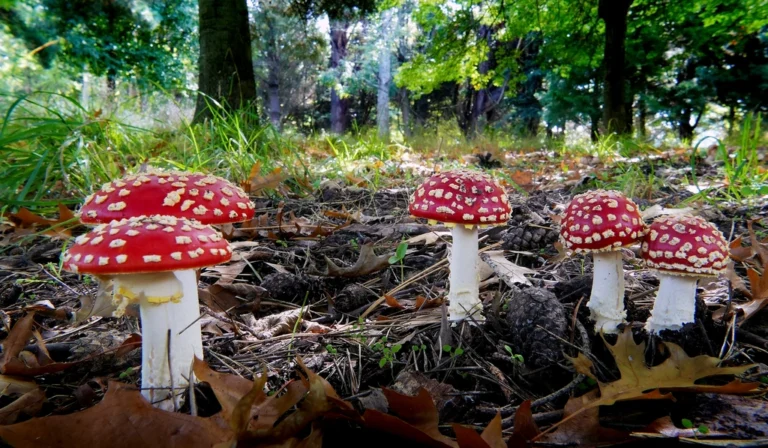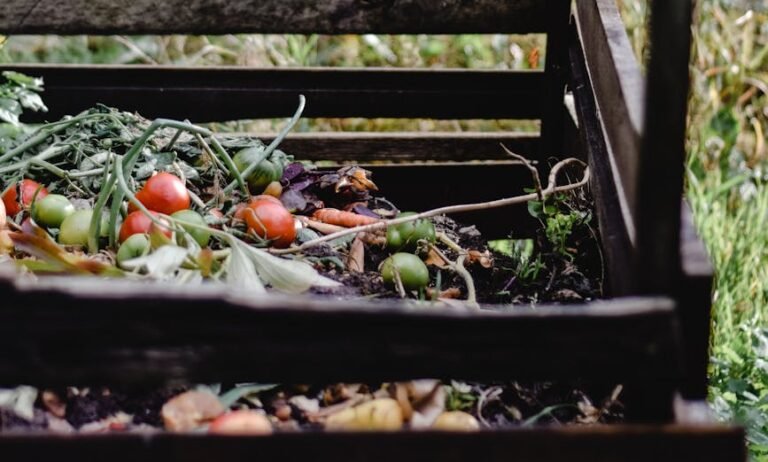
Introduction to Composting in Place
Composting in place is a gardening technique that involves utilizing organic materials directly in the garden area to enhance soil fertility and structure without the need for a traditional compost pile or bin. By layering organic matter such as kitchen scraps, yard waste, and other biodegradable material directly onto the garden bed, gardeners can promote decomposition naturally within their planting area. This method reduces waste and serves as a sustainable gardening practice that benefits both the environment and the gardener.
The core advantage of composting in place lies in its convenience and efficiency. Gardeners can utilize organic waste that would otherwise be discarded, turning it into a valuable resource. As these materials break down, they enrich the soil, improve moisture retention, and support beneficial microorganisms. Composting in place is particularly beneficial for raised bed gardens, as the enriched soil can significantly enhance plant growth and yield. The layering process allows for a self-sustaining ecosystem, feeding the plants while preventing the common problems associated with poor soil quality.
Moreover, composting in place can help to mitigate waste disposal issues by diverting compostable materials from landfills. As more individuals adopt this sustainable method, the overall workload of gardening can be substantially reduced. It is an accessible practice for novice and experienced gardeners alike, making it an ideal approach for those looking to maintain a garden without extensive resources. As we explore the nuances of creating raised bed gardens through composting in place, the focus will be on practical techniques that can seamlessly integrate this method into any gardening effort.

The Advantages of Raised Bed Gardens
Raised bed gardens offer numerous benefits that can enhance the gardening experience while promoting healthier plant growth. One of the primary advantages is improved soil drainage. The elevated structure of raised beds allows excess water to drain away more efficiently, preventing waterlogging and root rot, thus fostering a suitable environment for plant roots. This is especially beneficial in areas with heavy clay soil or regions prone to excessive rainfall.
In addition to drainage, raised bed gardens provide better soil quality. Gardeners have the freedom to create a custom soil mix tailored to the specific needs of their plants. By layering organic materials and compost, they can enhance soil fertility, structure, and nutrient availability over time. This tailored approach leads to healthier plants and, ultimately, higher yields. Furthermore, since the soil is contained within the raised structure, it is less likely to become compacted, which can hinder root growth and overall plant development.
Accessibility is another crucial advantage. For individuals with mobility challenges or those who simply prefer a more convenient gardening experience, raised beds can be constructed at a height that reduces strain during planting and maintenance tasks. This ease of access not only makes gardening more enjoyable but also encourages regular care and attention to the plants.
Moreover, raised bed gardens can significantly enhance the aesthetic appeal of any outdoor space. They provide a tidy and organized look, offering a visually pleasing contrast to traditional in-ground gardens. With thoughtful design, they can serve as functional focal points within a landscape. Additionally, by maximizing gardening space, gardeners can grow more plants in limited areas, making raised beds an ideal solution for urban settings or small yards.

Understanding the Layering Technique
The layering technique, often referred to as the “Lasagna Gardening” method, is an effective way to create raised bed gardens using composting in place. This method involves stacking various materials in alternating layers, which can include both greens—nitrogen-rich materials—and browns—carbon-rich materials. Understanding the composition of these layers is essential for fostering healthy soil and promoting plant growth.
Greens typically consist of fresh, green plant matter such as kitchen scraps, grass clippings, and green leaves. These materials are high in nitrogen, an essential nutrient that promotes robust vegetative growth. In contrast, browns include dried leaves, straw, and shredded paper. These carbon-rich materials provide the necessary balance to the compost and help improve the soil structure. By combining greens and browns in appropriate proportions, gardeners can create an optimal environment for microbial activity, which is critical for the composting process.
The layering technique also considers the importance of moisture and aeration in the compost pile. Each layer should be kept moist, but not soggy, ensuring that the decomposition process occurs efficiently. As organic materials break down, they generate heat, which further aids in the composting process. Additionally, the layers introduce varying textures, supporting air pockets that enhance aeration and drainage within the soil.
Over time, the steady breakdown of these layers will enrich the soil, improving its fertility and structure. This gradual transformation enhances the soil’s ability to retain moisture and nutrients which ultimately benefits the plants grown in the raised beds. The layering technique not only allows for effective composting but also significantly contributes to sustainable gardening practices, making it a valuable method for both novice and experienced gardeners alike.



Materials Needed for Composting in Place
Creating a successful composting in place system requires a thoughtful selection of materials that can contribute to both the composting process and the construction of raised bed gardens. The primary components of this method include kitchen scraps, yard waste, soil, and mulch. Together, these materials create a balanced mixture that promotes effective decomposition and enhances soil health.
Kitchen scraps are an excellent source of nitrogen-rich materials and serve as a foundational element in your compost. This category includes vegetable peels, fruit waste, eggshells, and coffee grounds. It is advisable to avoid adding meat, dairy, and oily foods, as these can attract pests and complicate the composting process. Yard waste complements kitchen scraps by providing bulk and structure to the compost mix. Leaves, grass clippings, and small branches are ideal for creating aeration pockets, which facilitate proper decomposition.
Soil is another essential material for composting in place, as it introduces microorganisms that aid in breaking down organic matter. Incorporating a layer of existing soil into your compost pile provides a rich source of beneficial bacteria and fungi. Additionally, mulch serves a dual purpose in both creating a weed barrier and retaining moisture in your raised bed. Organic materials like straw, wood chips, or shredded leaves can be used as mulch, gradually breaking down and enriching the soil over time.
Utilizing local resources, such as municipal yard waste programs or community gardens, can also enhance your composting efforts. These programs often provide free access to compostable materials that can double as organic matter for your raised beds. By balancing these various materials and understanding their roles, gardeners can effectively create a thriving compost system that leads to successful raised bed gardening.

Step-by-Step Guide to Composting in Place
Creating a raised bed garden through composting in place is an efficient method to enhance soil quality while simultaneously providing a sustainable source of nutrients for your plants. To begin this process, it is essential to select a suitable site in your garden. Look for an area that receives adequate sunlight and has good drainage. Once the site is determined, prepare the area by removing any grass or weeds. This step ensures that competing vegetation does not hinder the effectiveness of your compost layers.
The next stage involves layering, a crucial aspect of composting in place. Start with a base layer of coarse materials such as small branches or straw, which helps with aeration and drainage. Follow this with a layer of nitrogen-rich materials, such as kitchen scraps, grass clippings, or manure. It is noteworthy to alternate the carbon and nitrogen layers, ensuring a balanced mix. A general guideline is to create a ratio of 30 parts carbon to one part nitrogen. This balance prevents the compost from becoming too wet or too dry, helping it decompose effectively.
As you continue to layer, consider adding organic materials like leaves which will break down over time, enriching the soil. After establishing sufficient layers, cover the pile with a breathable material like wood chips to retain moisture and promote decomposition. Maintenance is key in this process; keep the compost moist. Regular monitoring will help in assessing the compost’s progress.
With patience and proper care, your compost will break down into rich, dark soil that serves as an excellent foundation for your raised bed garden. By adopting this layered approach to composting in place, gardeners create not only fertile beds but also contribute positively to the environment through sustainable gardening practices.

How to Maintain Your Raised Bed Garden
Maintaining a raised bed garden, particularly one established through the composting in place method, is essential for ensuring thriving plants and a productive harvest. One key aspect of maintenance is the proper watering technique. Raised beds typically offer better drainage than conventional gardens, which means that plants may require more frequent watering, particularly during dry spells. Implementing a routine to check soil moisture levels can help in determining when to water. A simple method to assess moisture is to insert your finger into the soil about an inch deep. If the soil feels dry at this depth, it’s time to water. Utilizing mulch on top of the soil can also help retain moisture and reduce evaporation.
In addition to watering, regular monitoring of soil health is vital. This implies checking for compaction and nutrient levels. Conducting soil tests can provide insight into pH levels and nutrient availability, facilitating informed decisions about amendments. Adding a fresh layer of compost annually will enhance soil fertility and structure, contributing to a more enriched growing environment.
Managing pests organically is another critical component of maintaining a healthy raised bed garden. Implementing a scouting routine to identify pests helps in taking early action. Encourage beneficial insects by planting flowers such as marigolds or dill, which can act as natural pest repellents. Additionally, introducing physical barriers like fragrant ground cover crops, such as pennyroyal or peppermint, can protect plants from common pests while allowing sunlight and moisture to permeate.
Finally, refreshing compost layers as needed is crucial for sustaining fertility. As organic materials decompose, they create rich nutrients for plants. Incorporating kitchen scraps or yard waste into the compost layers ensures a continuous supply of nutrients, benefiting plant growth. Regularly assessing the condition of the compost will help determine when it is time to replenish the layers, fostering a healthy, vibrant raised bed garden.

Common Mistakes to Avoid
When engaging in composting in place and establishing raised bed gardens, it is vital to be aware of common mistakes that can hinder success. One of the primary pitfalls is improper layering. Composting relies on a balance between browns, which are carbon-rich materials like shredded leaves, and greens, which consist of nitrogen-rich items such as kitchen scraps. Neglecting this balance can result in slow decomposition or unpleasant odors. Gardeners should strive to maintain a ratio of approximately three parts browns to one part greens to ensure optimal composting conditions.
Another significant error involves the use of unsuitable materials. Some individuals may be tempted to throw organic waste into the compost pile without consideration of its composition. Materials such as diseased plants, oily or fatty foods, and weeds with mature seeds can introduce pathogens or unwanted pests into the garden. It is essential to be discerning about the materials included in the composting process, choosing only those that will contribute positively to the overall health of the compost and the raised bed garden.
Furthermore, neglecting maintenance can lead to diminished results in both composting and raised bed gardening. Regular monitoring of moisture levels, temperature, and aeration is critical to ensure the compost breaks down effectively. Additionally, raised bed gardens require periodic attention to check for pests, diseases, and nutrient deficiencies. By failing to maintain these systems, gardeners may encounter challenges that could have been easily averted through routine care and observation.
By avoiding these common mistakes, individuals can greatly enhance their composting and gardening experience. Being mindful of proper layering techniques, selecting suitable materials, and committing to regular maintenance will lay the groundwork for a successful and fruitful raised bed garden. In conclusion, understanding these mistakes is essential for cultivating a thriving environment that flourishes through composting in place.

Encouraging Biodiversity in Your Garden
Creating a raised bed garden through composting in place is not solely about cultivating plants; it is also an opportunity to foster biodiversity, which plays a vital role in maintaining a healthy ecosystem. A diverse garden encourages beneficial insects, which are essential for pollination and pest control. For instance, ladybugs, lacewings, and parasitic wasps can keep pest populations in check, reducing the need for chemical interventions. To attract these helpful insects, consider incorporating a variety of flowering plants that provide nectar and pollen throughout the growing season.
Companion planting is a crucial strategy to enhance biodiversity within raised bed gardens. By planting compatible species in proximity, gardeners can optimize plant growth while simultaneously deterring pests and diseases. For example, marigolds are well-known for repelling nematodes and aphids, making them an excellent companion for vegetables such as tomatoes and peppers. Additionally, the strategic placement of plants can improve soil health by promoting nutrient cycling and minimizing competition for resources.
Utilizing native plants is another effective method to reinforce biodiversity in your garden. Native plants are well adapted to the local climate and soil conditions, making them easier to maintain while supporting local wildlife. They provide food and habitat for native pollinators and other beneficial organisms, thereby helping to create a balanced ecosystem. Incorporating a selection of native flora can improve your garden’s resilience to pests, diseases, and environmental changes.
By embracing these techniques, gardeners not only enhance the productivity of their raised beds but also contribute to a more sustainable planet. A biodiverse garden is less susceptible to disease and pest outbreaks, promoting long-term plant health and yielding a more abundant harvest.

Next Steps
As you consider embarking on your own raised bed gardening journey, keep in mind the key components of successful composting in place: choosing organic materials such as kitchen scraps and yard waste; maintaining moisture to facilitate decomposition; and ensuring proper aeration by turning the mixture occasionally. It is essential to be patient, as the process takes time, but the rewards of a nutrient-rich garden are well worth the wait.
For those eager to learn more local gardening workshops can provide valuable insights and support. Additionally, numerous online forums and community groups allow gardeners to connect, share challenges, and exchange tips.
We encourage you to share your experiences with composting in place and any gardening tips you may have in the comments section below. Your insights will inspire others to explore this rewarding practice. Together, we can foster a community dedicated to sustainable gardening and environmental stewardship. Now is the perfect time to take the next step towards cultivating your raised bed garden, enriching both your garden and personal growth.




